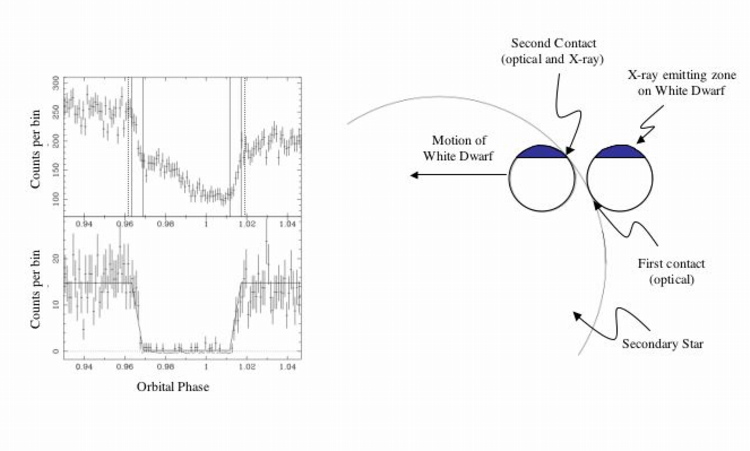
 Credit: Peter G. Wheatley & Richard G. West, 2003,
Monthly Notices of the Royal Astronomical Society, vol. 345, pg. 1009
Credit: Peter G. Wheatley & Richard G. West, 2003,
Monthly Notices of the Royal Astronomical Society, vol. 345, pg. 1009
Contacting a White Dwarf
Determining the size and structure of a white dwarf, an object as small as earth at astronomical distances is a difficult task indeed. Nature is sometimes kind, however and provides "laboratories" for astronomers. These laboratories are eclipsing binary stars, in which two stars bound together by gravity orbit each other and periodically eclipse each other. Near times of eclipse the change in brightness of the rearmost star as the edge of the companion moves across it can be used to locate bright and faint regions of the star. The image above shows the usefulness of this technique to help determine where X-rays are generated on an especially interesting system, a dwarf novae called OY Car, composed of a white dwarf primary and a normal star. On the left are "lightcurves" of OY Car obtained by the XMM-Newton X-ray observatory; the topmost is the variation of blue light versus orbital phase, while the bottom shows the X-ray eclipse of the system as the white dwarf moves behind the companion. On the right is a schematic showing the secondary companion star and the smaller white dwarf primary, as the white dwarf moves behind the secondary. "First contact" in the optical occurs when the edge of the white dwarf touches the edge of the secondary star, marking the start of the decline to eclipse minimum in the optical. This time is marked by the leftmost vertical dotted line in the blue lightcurve. Some time later the edge of the X-ray emitting region near the pole of the white dwarf (the blue shaded region) touches the edge of the secondary, designating the start of the decline to X-ray minimum; this is marked by the solid line next to the dotted line. Some time later the white dwarf moves completely behind the secondary, reaching "Second Contact", and both the X-ray and optical light reach eclipse minimum; this occurs simultaneously in X-rays and optical light.
Last Week *
HEA Dictionary * Archive
* Search HEAPOW
* Education
Each week the HEASARC
brings you new, exciting and beautiful images from X-ray and Gamma ray
astronomy. Check back each week and be sure to check out the HEAPOW archive!
Last modified Tuesday, 27-Feb-2024 10:10:14 EST


